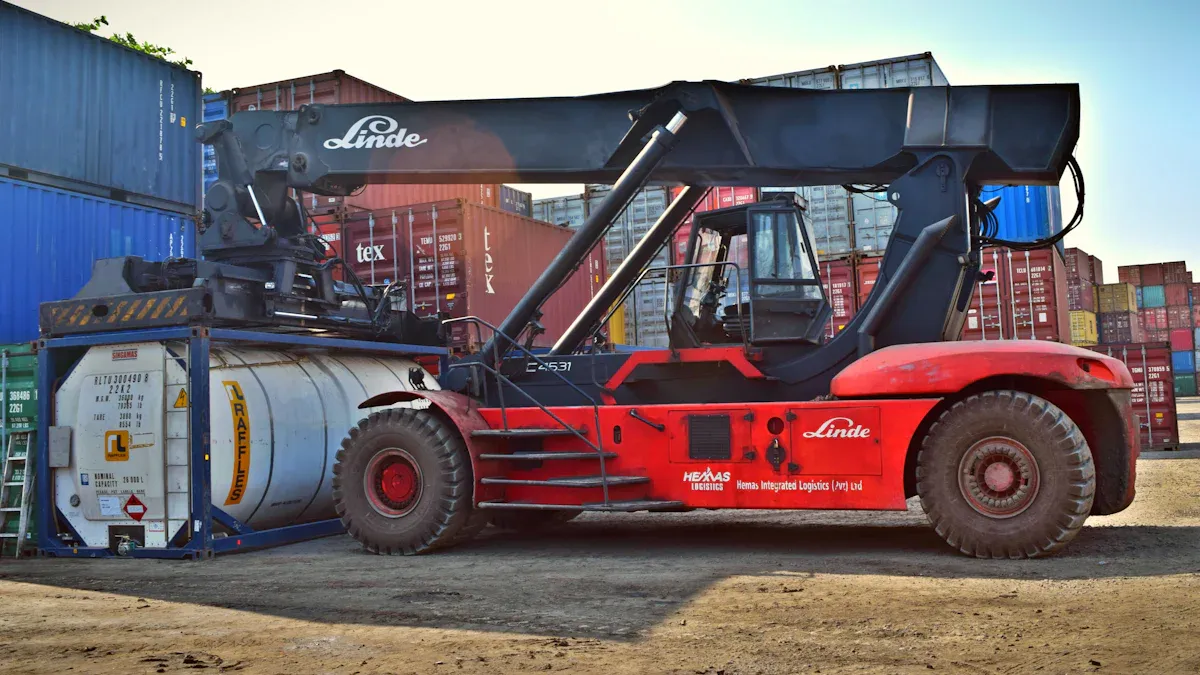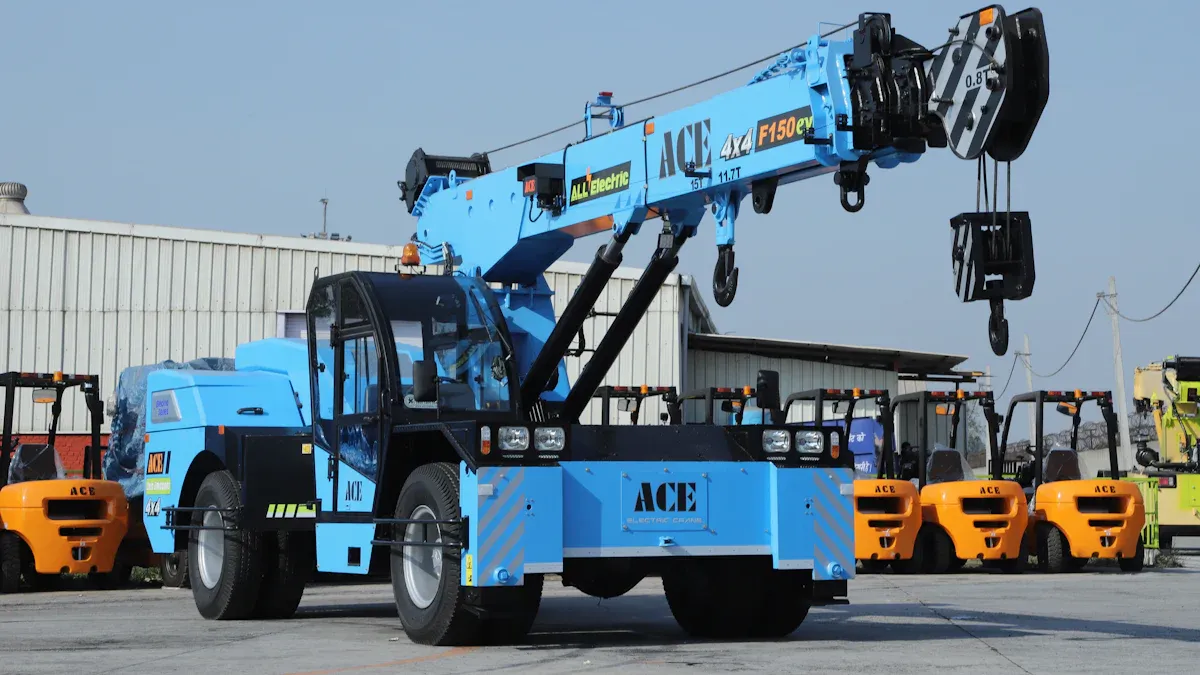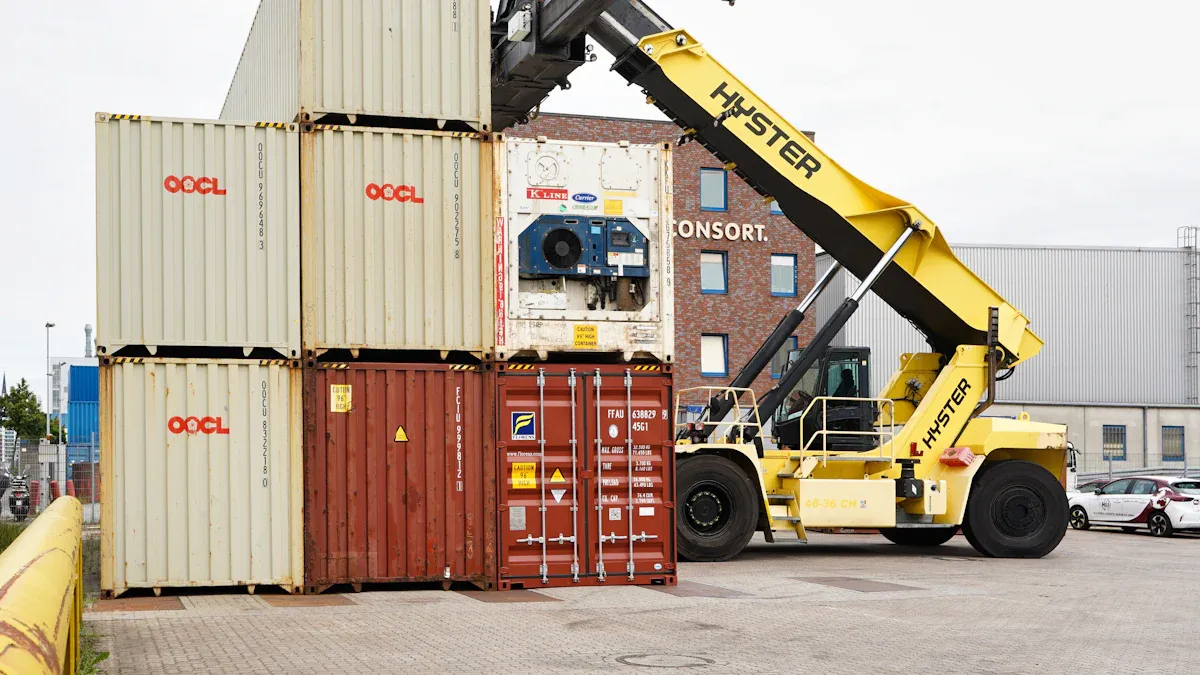

You use a reach stacker to lift, move, and stack containers or heavy cargo. This equipment plays a vital role in ports, terminals, freight yards, and warehouses. You benefit from its versatility, as it handles different lifting tasks, such as loading wind turbine parts or organizing goods in storage. When you need efficient and safe material handling, you rely on what is a reach stacker used for in daily operations.
What is a reach stacker used for

Container Handling
You rely on a reach stacker when you need to move, lift, and stack shipping containers quickly and safely. In ports and terminals, you often see a container reach stacker at work, handling different container sizes and types. This machine uses a telescopic boom and a spreader attachment to grab containers, making it easy to stack them high or move them across the yard.
Here are the main functions you use a reach stacker for in container handling:
Lift and stack containers up to five levels high, even in tight spaces.
Transport containers over short distances, such as from a ship to a storage area.
Rotate containers for precise alignment or inspection.
Adapt to various container types, including standard and high-cube models.
Speed up loading and unloading, which boosts efficiency in your logistics operations.
Tip: Reach stackers can stack containers up to three rows deep and five containers high. You can also place containers directly onto trains or trucks, which makes your workflow smoother.
When you compare a reach stacker to a traditional forklift, you notice big differences in speed, capacity, and stacking ability. The table below shows how each machine performs:
Feature | Reach Stackers | Traditional Forklifts |
|---|---|---|
Speed | Faster container movement | Slower due to limited reach |
Lifting Capacity | Up to 45 tons for fully loaded containers | Limited lifting capacity |
Maneuverability | Excellent in tight spaces | Less maneuverable in confined areas |
Stacking Ability | Can stack containers up to five levels high | Limited stacking height |
Technology Integration | Advanced automation and AI capabilities | Basic manual operation |
You use a container reach stacker to handle intermodal cargo containers efficiently. This equipment allows you to transport containers over short distances and stack them in different configurations. You can access containers stacked up to four deep, which gives you more flexibility and storage capacity than traditional forklifts.
Bulk Cargo and Heavy Lifting
You often face the challenge of moving heavy or oversized cargo, such as wind turbine parts or steel coils. In these situations, a reach stacker becomes your go-to solution for material handling. You can choose from different models, depending on the weight and size of your cargo.
Configuration | Weight Limit |
|---|---|
Small machines | 20 tons |
Larger models | Over 50 tons |
Row | Weight Limit |
|---|---|
First container row | Up to 45 tons |
Second container row | 30–35 tons |
Third container row | 20–25 tons |
You use a container reach stacker for stevedoring tasks, such as loading and unloading ships. The machine’s telescopic boom and strong lifting capacity help you move bulk cargo safely and efficiently. You can also handle non-containerized loads, making the reach stacker a versatile tool in your logistics operations.
Warehouse Operations
You benefit from a reach stacker in large warehouses where you need to manage many containers or heavy goods. This equipment streamlines your inventory management by allowing you to move containers quickly and stack them higher, which frees up valuable floor space.
You can optimize storage capacity by stacking containers up to five high.
You reduce manual labor and minimize downtime during container retrieval.
You enhance the flow of goods, which improves productivity.
Reach stackers play a key role in warehouse operations that require frequent stacking and retrieval of containers. You avoid congestion and keep your operations running smoothly. For example, you can use a reach stacker to organize goods, manage inventory, and prepare shipments for transport. This approach leads to higher productivity and lower labor costs.
When you ask, "what is a reach stacker used for," you see that the answer covers a wide range of tasks. You use this machine for container handling, bulk cargo, and warehouse operations. Each use helps you achieve greater efficiency and flexibility in your daily logistics and material handling activities.
Reach stacker functions
Lifting and Stacking
You use a reach stacker when you need to lift and stack containers with precision and speed. This machine features a telescopic boom that extends and retracts, allowing you to reach containers at different distances. The boom holds a spreader with twistlocks, which grip the top of the container securely. You can lift loads between 10 and 46 tons, making the reach stacker a powerful tool in busy shipping yards.
Note: The reach stacker can stack containers up to six high, which helps you maximize storage in limited spaces.
Here is a comparison of common lifting and stacking machines:
Machine Type | Lifting Style | Best For | Flexibility |
|---|---|---|---|
Reach Stacker | Top lift (telescopic boom) | Ports, rail yards, mid-sized terminals | High |
Forklift | Bottom lift | Warehouses, low-stacking jobs | Medium |
Gantry Crane | Overhead lift | Mega ports, high-volume yards | Low |
Straddle Carrier | Straddle lift | Large-scale container parks | Medium |
You notice that a reach stacker offers more flexibility than gantry cranes or forklifts. While gantry cranes can lift heavier loads, you benefit from the reach stacker's ability to work in tighter spaces and handle different container sizes. This makes your material handling tasks more efficient.
Short-Distance Transport
You often need to move containers or heavy cargo over short distances within a port, terminal, or storage yard. The reach stacker excels in this role. Its articulated steering and hydraulic system let you navigate tight corners and confined areas with ease. You can transport containers from ships to trucks or trains quickly, keeping your operations running smoothly.
Feature | Contribution to Optimization |
|---|---|
Adjustable Hook/Spreader | Handles various container sizes efficiently |
Hydraulic System | Lifts and moves containers with precision |
Articulated Steering | Navigates tight spaces effectively |
Control Center | Lets you manage operations seamlessly |
Stability and Maneuverability | Ensures safe stacking and movement in confined areas |
You rely on the reach stacker to optimize container movement and stacking, especially where space is limited. This machine helps you keep cargo organized and accessible, which improves workflow and reduces delays.
Container reach stacker applications

Ports and Terminals
You often see a reach stacker working in busy ports and terminals. This machine helps you move containers quickly, even when space is tight. Its advanced controls and high lifting capacity make it essential for efficient cargo management. You can load and unload containers at high speeds, which reduces waiting times for trucks and ships. The powerful engine and hydraulic system let you handle containers smoothly, even in crowded areas. You keep cargo flowing and avoid delays, which is vital for meeting tight shipping schedules.
Reach stackers operate in confined spaces, making them ideal for busy terminals.
High maneuverability allows you to navigate tight corners and narrow aisles.
Fast container turnover keeps your supply chain moving.
Tip: Using a reach stacker helps you reduce the number of times you need to move a container to reach the one you want, saving time and effort.
Storage Yards
In storage yards, you rely on a reach stacker to maximize space and organize containers efficiently. The compact design lets you stack containers up to five high, which increases your storage capacity. You can retrieve containers from different rows without moving others, which improves workflow. The telescopic boom gives you access to high-stacked containers, so you do not need extra equipment.
Efficient stacking and retrieval help you make the most of your yard space.
You can operate from one side of the yard, which changes the layout and improves pickup efficiency.
Fewer re-handles mean less wear on containers and equipment.
Intermodal Facilities
You use a reach stacker in intermodal facilities to transfer containers between ships, trains, and trucks. This process does not require you to handle the freight inside the container, which saves time and reduces the risk of damage. The machine enables rapid transitions between transport modes, cutting down dwell times and speeding up delivery. You benefit from faster loading and unloading, which can reduce handling time by up to 20%.
Advantage | Description |
|---|---|
Versatility | Handles different container sizes and types |
Efficient Container Stacking | Stacks containers up to five high, optimizing space |
Quick Intermodal Operations | Speeds up transfers between ships, trains, and trucks |
Time and Cost Efficiency | Cuts loading/unloading time and labor costs |
You keep your supply chain efficient and organized by using a reach stacker in these key environments.
Advantages of reach stackers
Flexibility
You gain unmatched flexibility when you use a reach stacker for your cargo operations. This machine adapts to many types of loads, including standard containers, flat racks, and even oversized items. You can handle palletized goods, long materials, and bulk cargo with ease. The adjustable spreaders and specialized attachments let you switch between different cargo types quickly. You also benefit from the ability to stack containers in the second and third rows, which increases your storage options.
Feature | Description |
|---|---|
Stacking Capability | Stack containers in multiple rows and heights |
Maneuverability | Operate in tight spaces and narrow aisles |
Handling Flexibility | Manage various container sizes and weights |
Speed | Move cargo quickly across the yard |
Operator Comfort | Use safety features for better control and visibility |
You can rely on a reach stacker to work in ports, terminals, and warehouses. This flexibility makes it a top choice for many logistics companies.
Efficiency
You improve your workflow and save time with a reach stacker. The machine moves at high speeds and lifts heavy loads with precision. You can complete loading and unloading tasks faster than with traditional forklifts or cranes. The telescopic boom and advanced controls help you reach containers stacked several units high or deep in the yard. You also reduce the number of moves needed to access specific containers, which keeps your operations smooth.
Move containers from ground level to high stacks in seconds.
Operate in narrow aisles without sacrificing speed.
Handle fragile or oversized cargo with gentle, precise controls.
You keep your logistics chain moving efficiently, even during busy periods.
Cost Benefits
You lower your operational costs when you choose a reach stacker over cranes or manual systems. Automated models can cut expenses by over 50% compared to traditional equipment. You also save on labor and maintenance because the machine needs fewer operators and less downtime. In some terminals, annual cost savings reach over 13%. These savings grow even more in regions like North America and Oceania.
Tip: For the best value and performance, consider leading brands such as TONA. Their reach stackers offer advanced features and reliable support, making them a smart investment for your cargo handling needs.
You maximize your budget while boosting productivity and safety in your daily operations.
You gain many advantages when you use a reach stacker in your logistics operations. This machine helps you move heavy containers, work in tight spaces, and improve safety. The table below shows some of the most important features:
Feature | Description |
|---|---|
High lifting capacity | Handles containers up to 45 tons |
Flexible operation | Works well in confined areas |
Advanced safety | Includes load sensors and stability controls |
Reach stackers help you keep cargo moving quickly and safely, which is vital for global trade. For reliable performance, consider trusted brands like TONA, Konecranes, or Kalmar.
FAQ
What is the maximum weight a reach stacker can lift?
You can lift up to 45 tons with most standard reach stackers. Some heavy-duty models handle even more. Always check your machine’s manual for exact limits.
Can you use a reach stacker indoors?
Yes, you can use a reach stacker in large warehouses or storage facilities. Make sure the space has enough height and width for safe operation.
How does a reach stacker differ from a forklift?
A reach stacker lifts containers from the top and stacks them higher than a forklift. You get better reach, higher stacking, and more flexibility in tight spaces.
What types of cargo can you move with a reach stacker?
You can move shipping containers, bulk cargo, steel coils, wind turbine parts, and palletized goods. Specialized attachments help you handle different loads safely.
Do you need special training to operate a reach stacker?
Yes, you need certified training to operate a reach stacker. Training helps you learn safety rules, controls, and best practices for efficient cargo handling.









